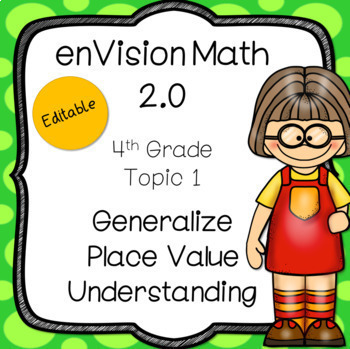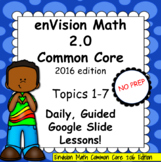enVision 2.0 Common Core (2016) Topic 1 Place Value Understanding 4th grade
- Google Slides™

What educators are saying
Also included in
- This bundle includes daily Google Slide lessons for the first 4 topics/units of the enVision Math 2.0 program. While the teaching slides and question slides match the sequence taught in the student workbook, none of the examples are copied/taken from the book. You don't have to worry about duplicatePrice $17.10Original Price $19.00Save $1.90
- SEE VIDEO PREVIEWS! - Ready-to-go, no prep lessons! This can save you a TON of time planning! 1,304 slides are included, organized in order for each lesson in every topic. View all Units for the EnVision 2.0, (2016) curriculum here. Need the 2012 Version? Click here. Need the 2020 Common Core versioPrice $25.29Original Price $28.10Save $2.81
- Google Slide Guided lessons for the WHOLE YEAR! 2,896 slides! Your lessons - what you and your students do each day including the practice problems and discussions are ready to go! All they need is a skilled teacher to guide them through it! These daily Google Slides will take you and your studentsPrice $64.58Original Price $71.75Save $7.17
Description
VIDEO PREVIEW! Ready to go, Daily Lessons, done for you! This Google Slide Unit contains 134 guided slides for lessons 1-1 through 1-5 from the EnVision Math 2.0 (2016 Version). These daily Google Slides will take you and your students through each lesson in the topic. While the teaching slides and question slides match the sequence taught in the student workbook, none of the examples are copied/taken from the book. You don't have to worry about duplicates! I have looked at each skill and then created slides to help simplify the teaching of the skill as well as give students practice as a class so that they are then ready to tackle their workbooks with confidence.
WHAT'S INCLUDED IN EACH DAY'S GUIDED SLIDE LESSON:
Each day begins with the lesson title, the objective for the day (I have students read this), any needed vocabulary, and then guided practice problems and problems for students to answer independently as they apply what they've learned and work towards mastery. Word problems are also included after students have an opportunity to practice the skill in isolation. The lessons conclude with a "closing discussion" that provides students an opportunity to verbalize and review what they have learned that day. Finally, I add a "next steps" blank slide so that you can add the next steps for your class (workbook page/homework/etc).
I provide answer slides after the questions so that students can also compare their answers for accuracy. Sides take it slow, so students start off by not only practicing the skill, but learning how and why steps are taken in order to solve.
Slides give guidance for you, too! I have small notes letting you know if you should go on to the next slide and also give you a heads up if the next slide contains the answer, so you don't show it before students have an opportunity to solve it themselves. I use these notes for myself as well, because I can never remember what slide comes next. This makes them foolproof!
They are fully editable so you can add/change anything that you need to meet the needs of your classroom.
IN MY OWN CLASSROOM: I start off each math class with a math warmup. This introduces students to new skills and reviews "old" skills. It doesn't take long and is great to keep students working on all math domains, even though the book focuses on one at a time. It also keeps them busy while I'm collecting homework. Then, we do our guided slides together and then students either work independently, with a partner, or with me on their workbook. I typically don't assign all of the guided practice problems because that alone would take 40 minutes for most kids. I pick and choose what I want them to complete (what I'll grade) and then tell them to work on the rest until time is up. Then, they work on the homework page for homework that evening.
View all Units for the EnVision 2.0, (2016) curriculum here.
Topic 1 Lessons in this product include:
1-1 Numbers Through One Million
1-2 Place Value Relationships
1-3 Compare Whole Numbers
1-4 Round Whole Numbers
1-5 Math Practicing & Problem Solving: Construct Arguments








